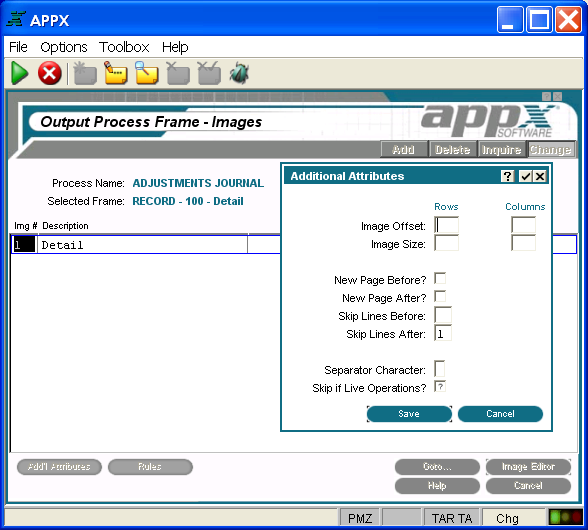Chapter 3-7: Output Processes |
Non-Scrolling Output Image Additional Attributes Option When you select the Additional Attributes option on the Non-Scrolling Output Images screen, the non-scrolling output image Additional Attributes overlay is displayed as shown below, where you can access additional parameters.
Non-Scrolling Output Image Additional Attributes Overlay The non-scrolling output image Additional Attributes overlay contains the following options: Image Offset determines the placement of the rows and columns of this image, relative to the frame. Row entries designate positioning, relative to the top of the frame. Column entries designate positioning relative to the left of the frame. If blank, the APPX defaults to same row/column position as the frame. The default is blank. See Frame/Image Positioning for more information. Image Size designates the number of rows and columns that comprise the displayed image. The image cannot be larger than the frame it belongs to. If blank, the size of the image defaults to the size of the frame. The default is blank.
New Page Before? indicates whether or not a new page should be started before each time this image is printed. Click the checkbox to toggle between 'yes'
New Page After? indicates if a new page should be started after the image is printed. Click the checkbox to toggle between 'yes' Skip Lines Before represents the number of lines to be skipped prior to the image being printed. Skip Lines After defines the number of lines to be skipped after the image is printed. Separator Character indicates whether a continuous line of a designated character (usually -, =, or *) should be following this image to separate it from the rest of the report. This field is optional and leaving it blank indicates that no separation line is to be printed.
Skip If Live Operations? determines whether the frame is exclusive to the initial setup and recovery processing phases of operation. If 'yes' |
Application Design Manual "Powered by Appx Software"350 ©2006 By APPX Software, Inc. All Rights Reserved |
